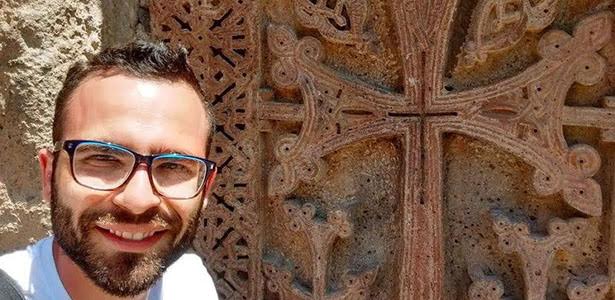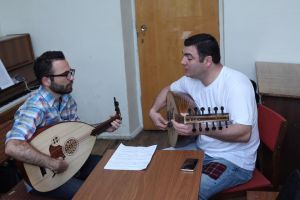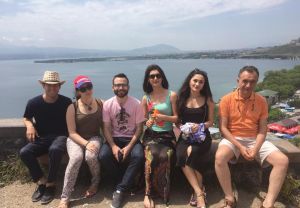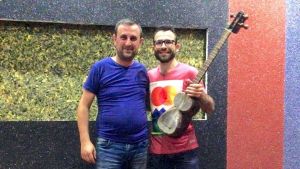Cordoba-Armenian musician: “My great-grandfather lived next to Komitas Vardapet”

Hayern Aysor’s correspondent sat down for an interview with musician Alejandro Demdemian from the Argentine city of Cordoba. From July 9 to August 19, Demdemian was in Armenia to examine Armenian national musical instruments and discover the secrets of Armenian dances.
With this visit, Alejandro became more connected to Armenia and Armenians, and he addressed them during the interview.
Hayern Aysor: Do you visit Armenia often, Alejandro?
Alejandro Demdemian: This is my second visit to Armenia. I first visited as a tourist, but this time I am here to discover Armenia and Armenian culture in its entirety.
The AGBU Central Board carries out an Armenian summer cultural program that provides Diaspora Armenian youth with the opportunity to take training courses on Armenian songs, dances and national musical instruments for a period of twenty days.
I chose to take training courses on the Armenian tar and ud instruments and Armenian dances.
I was included in the program with the help of secretary of AGBU Argentina and honorary member of AGBU Central Board Antonio Sarafian and AGBU Argentina, for which I am very grateful.
After the program, I stayed in Armenia for another twenty days to continue to take courses thanks to the good will of Argentine-Armenian musician and public figure Gagik Gasparyan and his wife, artistic director of Cordoba’s Ararat Dance Ensemble Veronica Karadakhian and AGBU Cordoba Chapter. They helped and encouraged me a lot.
As a matter of fact, I am also a member of Ararat Dance Ensemble.
Hayern Aysor: Do you think your visit to Armenia was effective? What progress did you notice during the master classes?
A. D.: I discovered many things during my visit to Armenia. I will apply all the professional skills and use my abilities for the rest of my life.
Throughout the 40-day visit, I took master classes with tar player Armen Yeganyan and ud player Aram Nikoghosyan. As for dance, I attended the lessons conducted by Karin Ethnographic Song and Dance Ensemble Gagik Ginosyan.
I will definitely visit Armenia again. The days that I spent in an Armenian environment helped me gain a lot of experience and conveyed the feeling of patriotism.
I would like to thank those who didn’t spare any effort, worked with me and filled me with warmth. I would like to express special gratitude to tar player Armen Yeganyan for generously rehearsing with me for twenty consecutive days after the program ended.
Hayern Aysor: Did life abroad make you decide to examine Armenian musical instruments, or is there another “hidden” reason behind all this?
A. D.: My grandmother is the reason why I started showing interest in Armenian music. She had always urged me to love and listen to Armenian music ever since childhood. I especially like the sounds of the tar instrument. After listening to a performance with the tar during one of Gusan Group’s concerts in Cordoba, I was surprised and decided to examine that musical instrument in more detail.
Hayern Aysor: Are there Armenian dances or musical performances that you prefer?
A. D.: Out of the Armenian dances, I like the “Kochari” and “Yarkhushta” dances and the “Mayroke” song/dance. The works of Sayat-Nova and Komitas are my musical “escorts” that I can constantly listen to and never get tired.
True, I don’t understand the words because I don’t know Armenian, but I listen to them with great pleasure because the melodies are nice.
Besides, I have been hearing those songs at home since childhood and they are now close to my heart.
Hayern Aysor: What do you know about your ancestors?
A. D.: My ancestors were eyewitnesses of the Armenian Genocide. Escaping the Turkish yataghan, they settled in France and later in Greece. Afterwards, they moved to Buenos Aires and later to Cordoba.
My great-grandparents were originally from the Kyotahia city of Western Armenia, the place where great Armenian composer Komitas was born. My grandfather’s home was located next to Komitas’s home. According to my grandfather, Komitas would sing so loudly that his voice would make all the walls shake.
Hayern Aysor: Did the program envisage cognitive visits to historic and cultural sites in Armenia?
A. D.: Yes, the organizers had thought about that in advance. I visited Lake Sevan, the pagan temple in Garni, Geghard Monastery, the Mother See of Holy Etchmiadzin, Khor Virap Monastery, Hankavan, Dilijan, Sardarapat Memorial Complex, Tsitsernakaberd Armenian Genocide Memorial Complex and Tatev Monastery. I really liked Tatev Monastery and all the places in Yerevan from where I could look at Mount Ararat.
I admire the centuries-old Armenian culture, churches, as well as the buildings, architectural masterpieces. I took pride in all that and felt happy that we Armenians have such national values.
I became convinced once again of how kind, friendly and hospitable Armenians are. It was a great pleasure for me to communicate with my fellow Armenians.
I would like to visit Armenia more often and establish new contacts. I still can’t say if I will be able to settle here since I haven’t thought about that. I envision my future in Argentina.
Hayern Aysor: What else do you do in Argentina?
A. D.: I study at the University of Architecture of Argentina and teach children at an Armenian school in Cordoba. No matter what I do, music is always in my focus.
I always disseminate Armenian music and urge my foreign friends to listen to Armenian songs. My Armenian friends and I often gather and talk about different topics. We especially talk about our future plans to contribute to Armenia’s advancement.
I am also an active member of the Armenian community, which carries out different cultural programs. For instance, Ararat Dance Group gives a concert once a week.
One of the organizers of the cultural events is musician Gagik Gasparyan, who carries out different kinds of programs to preserve the Armenian identity and support young Argentine-Armenians.
Hayern Aysor: You are so patriotic, yet you don’t speak Armenian. How did that happen? Are you trying to learn Armenian?
A. D.: I think the fact that my mother is of Argentine descent had an impact. When I was about to go to school, my parents decided to take me to an Argentine school in the mornings and to an Armenian school in the evenings.
However, for some reasons, plans changed, and they took me to learn Armenian songs. So, I wasn’t able to learn Armenian.
It is never too late to learn. I will definitely fix the flaw.
Hayern Aysor: So, you are the son of an Armenian and an Argentine. Which morals does your family preserve more?
A. D.: Although my mother is Argentine, she always says there has to be an Armenian environment at home. My family and I always celebrate Armenian national and church holidays.
My mother attends the AGBU’s training courses devoted to Armenian national dishes and learns how to make different kinds of dishes. What helps my mother a lot is the Armenian culinary arts book that my grandmother gave her as a gift.
My mother makes dolma, manti and other dishes for us.
When I return to Cordoba, I am going to ask her to make them again since I have missed their taste.
P.S.: At the editorial office of Hayern Aysor, Alejandro Demdemian was accompanied by tar player Armen Yeganyan, who had held master classes for the Argentina-based musician.
The tar player said the following as he shared his impressions of Alejandro Demdemian:
“I was surprised when I found out that a young Argentine-Armenian was going to come to Armenia to examine the Armenian tar and ud instruments. Unfortunately, there are not many people who are interested in those musical instruments today.
Alejandro is a very smart and hard-working person. Music is his world, and he has a great desire to examine the origins of Armenian music. The most important thing is that he has a sense of national belonging and considers himself a full Armenian.
It is safe to say that he is a musician who has received the right professional education. It was a pleasure for me to teach him. I am very content.
Listening to Alejandro’s impressive performance, I realized how much he loves Armenian music. Alejandro was constantly asking me questions with the desire to receive all kinds of information about the tar instrument.
We have agreed to keep in touch when we return to Cordoba. We will conduct lessons via long distance in order to reinforce his musical knowledge.
Interview by Gevorg Chichyan
Translation from Spanish to Armenian and vice versa by Narek Tadevosyan




 Արևելահայերեն
Արևելահայերեն Արևմտահայերեն
Արևմտահայերեն Русский
Русский









